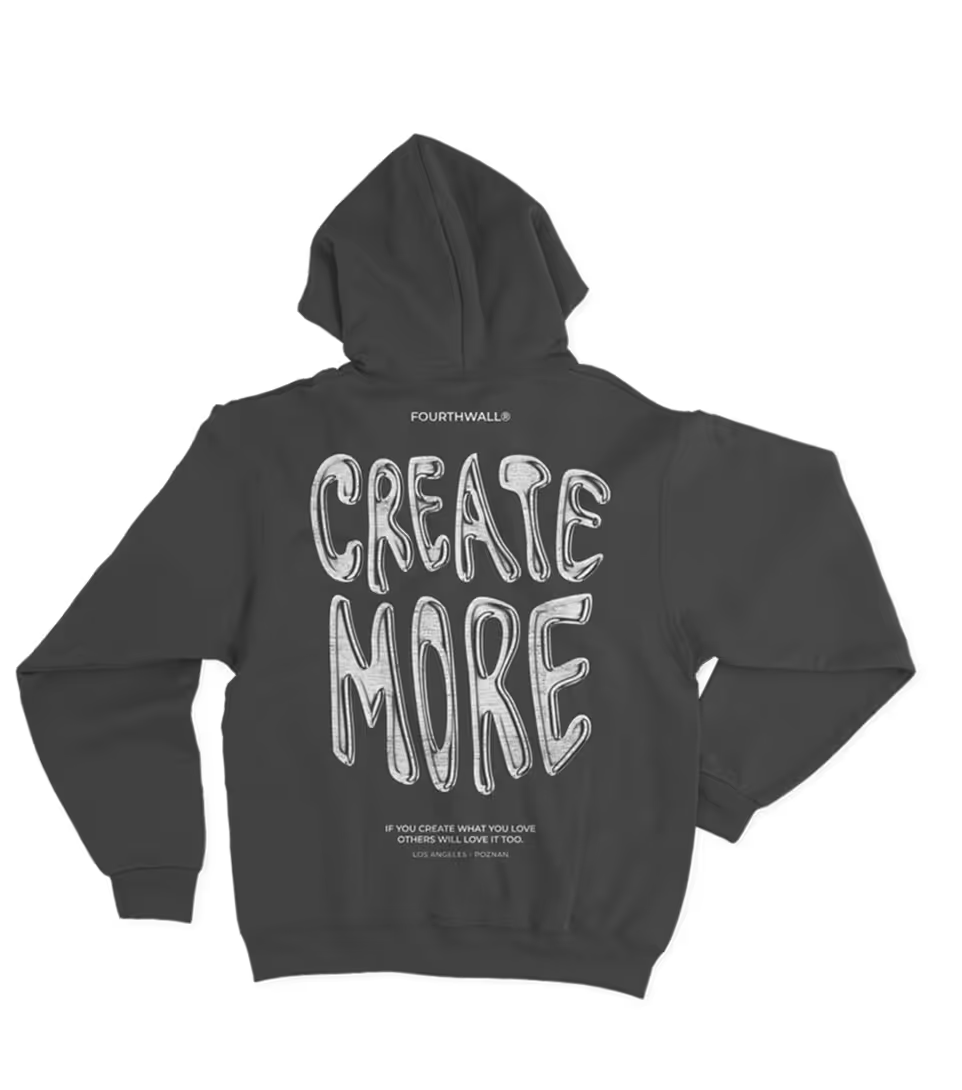16 Best Digital Products for You to Sell

Digital products are becoming increasingly popular to sell online, in part because the possibilities with these products are endless! Whether it’s an e-book, an online course, a digital art print, or a font pack, we'll help you figure out exactly what digital products are, and why they're so significant for creators.
In short, digital products are intangible (not physical) goods that can be downloaded or accessed online. With little to no costs to the creator (except time!), and the power to reach any audience in seconds, selling digital products can be a lucrative and rewarding way for creators to monetize their talents.
If you’re a creator looking to diversify your income stream by offering digital products, there's lots to consider. We'll discuss which types of digital products are most popular, the benefits of selling digital products, and strategies to succeed by selling digital products on an ecommerce platform, including Fourthwall.
What are Digital Products?
Digital products are non-material goods that can be distributed via digital channels such as email, embedded download links on websites, or through online shops like Shopify, Etsy, or Fourthwall. Some popular examples of digital products to sell are ebooks, music, templates, stock photos, online courses, audio content, downloadable art, and membership content/subscriptions.
Digital products are easy to access and distribute, require no physical storage space, and often have lower-to-no production costs, allowing creators to sell them at a lower price. Customers can access digital products on demand, anytime, anywhere, using their computers, smartphones, or tablets. Ecommerce platforms like Fourthwall have been making it easier than ever for creators to monetize their skills and expertise by allowing them to sell digital products online!
Why Sell Digital Products?
There are several reasons why creators and influencers should consider selling digital products. Let's take a closer look at 6 key reasons:
- Diversify Income Streams: Selling digital products allows creators to diversify their income sources beyond traditional channels like advertising and sponsorships, bringing additional stability to their revenue streams while also ensuring sustainability.
- Build Deeper Relationships with Your Fans: By offering exclusive, premium digital products like memberships, downloadable courses, and personalized content, creators can nurture more meaningful relationships with their fans, enabling them to establish a loyal and supportive community.
- Demonstrate Your Expertise: Digital products like ebooks, courses, tutorials, and workshops enable creators to showcase their knowledge and expertise on specific topics, establishing themselves as authorities in their respective fields.
- Monetize Existing Content: Creators can monetize existing content through digital products, transforming their blogs, podcasts, videos, and social media posts into ebooks, guides, and multimedia content.
- Control Over Pricing: Creators have full control over the pricing of their digital products, enabling them to set fair prices based on the amount of work, value proposition, and market demand for their offerings.
- Passive Income Potential: Creating digital products to sell online can become a passive income stream once the initial work is done. The products will continue to generate revenue even while the creator is working on other projects.
16 Best Digital Product Ideas to Sell in 2025
Digital products have revolutionized the way businesses work, and with the increasing demand for virtual goods, this continues to be an exciting opportunity for all kinds of creators to grow and generate passive income. Here are ten trending digital products to sell that offer promising prospects for creators and sellers:
1. Online Courses

Creating and selling online courses presents an excellent opportunity for individuals to share their expertise in subjects they are knowledgeable about, such as programming, graphic design, photography, or personal development.
With the increasing demand for online learning, platforms like Udemy, Teachable, and Coursera provide a convenient way to reach a broad audience of eager learners seeking new skills.
By structuring your courses to include engaging video lessons, interactive quizzes, and other downloadable resources, you can create a comprehensive learning experience that caters to different learning styles.
Moreover, incorporating community elements, such as discussion forums or live Q&A sessions, can enhance engagement and foster a supportive learning environment.
Pros:
- The growing popularity of online learning creates a significant market for courses across various subjects, making it a lucrative opportunity.
- Once your digital download course is created and launched, it can generate ongoing revenue as new students enroll, often with minimal additional effort.
- You can design your courses to fit your schedule and work at your own pace, allowing for a better work-life balance.
Cons:
- Students expect professional-grade content and a seamless learning experience; failing to meet these expectations can lead to negative reviews and reduced enrollment.
- Navigating course creation and hosting platforms may pose challenges for those less familiar with technology, potentially limiting your audience.
- Regular updates to course content may be necessary to keep it relevant and engaging, which can demand ongoing time and effort.
2. EBooks

Selling eBooks online is a highly effective option for authors and creators looking to publish their work and reach a wider audience without the financial burden of traditional publishing costs.
Platforms like Amazon Kindle Direct Publishing (KDP) and Smashwords allow you to easily distribute your digital books to a global audience, enabling readers from various backgrounds to access your content.
For example, Say It In Swedish successfully markets language-learning eBooks, catering to a niche audience eager to acquire new skills. By focusing on specific topics or themes, authors can tap into underserved markets, offering tailored content that meets the unique needs of their readers.
Additionally, the ease of updating eBook content ensures that authors can keep their work relevant by revising information or incorporating new trends.
The versatility of eBooks allows for various formats, including interactive elements such as hyperlinks, videos, or quizzes, which can enhance the reader's experience and engagement.
Pros:
- Unlike traditional publishing, selling eBooks incurs minimal costs, allowing authors to retain a larger percentage of sales revenue.
- Ebooks can be distributed worldwide, making it easy to connect with a diverse audience and expand your reader base.
- Ebooks can be created in various formats, such as PDF, ePub, or Kindle, catering to different reading preferences and devices.
Cons:
- The eBook market is crowded, making it challenging for new authors to stand out among countless titles and attract readers.
- Ebooks may lack the interactivity of other digital products, which could limit engagement and reader retention.
- Some readers may face difficulties with file formats or e-reader compatibility, which could affect their overall experience.
3. Podcasts
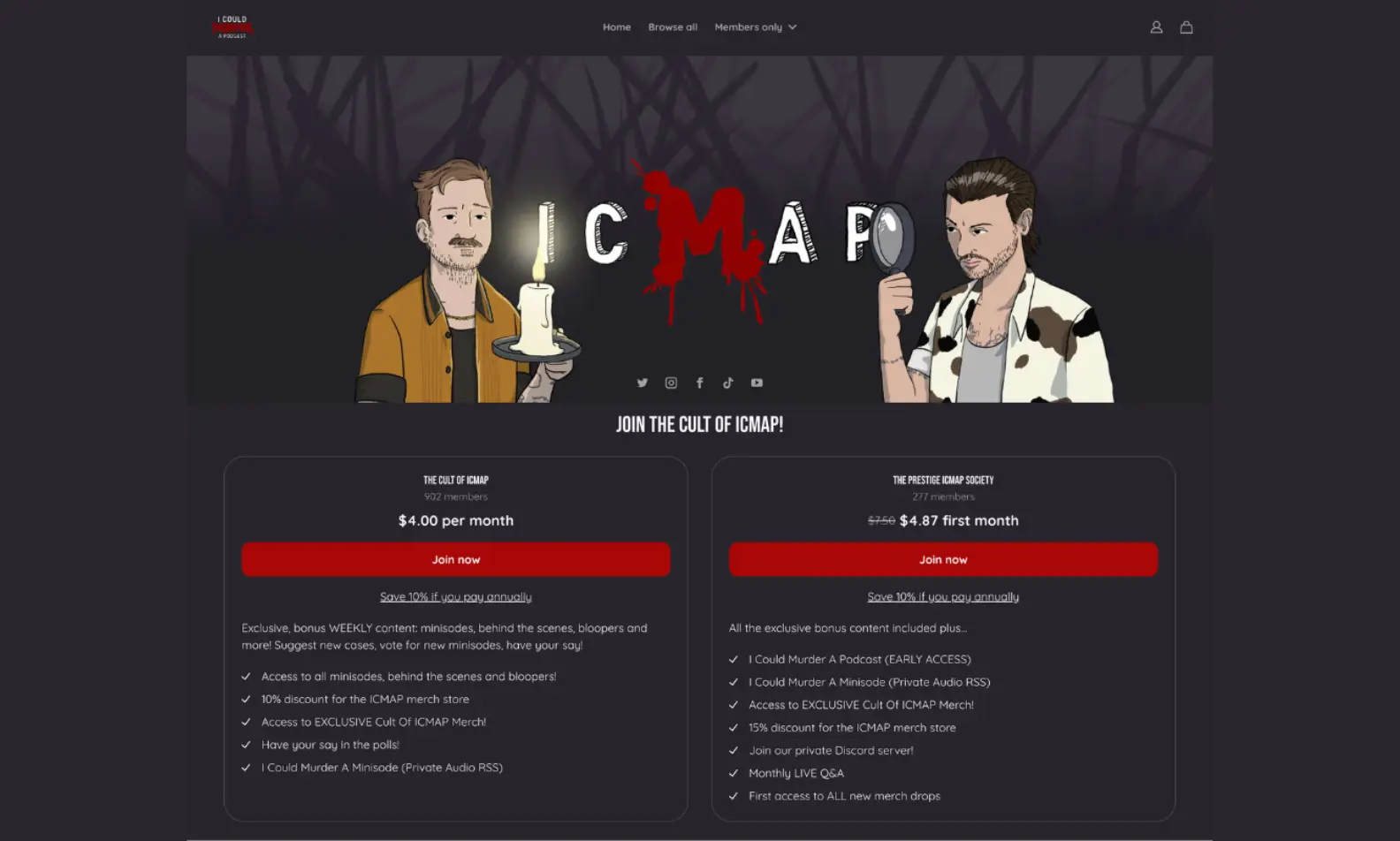
Podcasts are rapidly growing in popularity, and creators can monetize their expertise in this digital product by creating engaging podcast content and offering exclusive episodes to niche audiences.
By producing engaging podcast content, creators can monetize their efforts through various avenues, including sponsorships, listener donations, and subscription models that offer exclusive episodes or bonus content to niche audiences.
And with the ease of distribution via platforms like Apple Podcasts, Spotify, and YouTube Podcasts (formerly Google Podcasts) means that your episodes can reach listeners wherever they are, whether commuting, exercising, or simply relaxing at home.
For more information on how you can monetize your podcast, check out our Fourthwall article here!
Pros:
- Podcasters can generate revenue through various channels, including sponsorships, ads, listener donations, and premium subscriptions for exclusive content.
- They can cover a wide range of topics, enabling creators to target specific niches and attract dedicated listeners.
- Compared to other media, starting a podcast can be relatively inexpensive, requiring only basic recording equipment and editing software.
Cons:
- The podcasting space is crowded, making it challenging for new creators to stand out and gain visibility among countless existing shows.
- Building a sizable audience to attract sponsorships or significant revenue can take time and consistent effort, posing initial financial challenges for creators.
- Successfully growing a podcast audience often necessitates ongoing marketing and promotional efforts to maintain listener interest and attract new followers.
4. Digital Art

Digital art is rapidly gaining popularity, providing creators with an exciting opportunity to sell a diverse array of artworks online, including prints, comics, digital illustrations, and NFTs.
This expanding market allows artists to showcase their unique styles and skills via digital products, while reaching audiences eager to discover and actually purchase digital creations.
Many creators utilize platforms such as Fourthwall and Etsy to set up shops where they can sell digital art files that customers can download, print, and display in their homes, effectively transforming their work into decor or gifts.
This model not only eliminates the need for physical inventory but also enables artists to cater to various customer preferences by offering customizable print options and unique designs.
Pros:
- Selling digital art eliminates the need for physical inventory, reducing costs associated with printing and shipping.
- Digital art can be offered in various formats (e.g., prints, wallpapers, and merchandise), catering to different customer preferences and needs.
- Artists can diversify their income by selling not only their artwork but also offering tutorials or workshops on creating digital art, expanding their audience engagement.
Cons:
- The digital art market is saturated, making it challenging for new artists to differentiate themselves and gain visibility.
- Artists must be vigilant about copyright issues, as their work can be easily copied or misused online, potentially leading to disputes.
- Some buyers may face difficulties with the file formats or printing of digital products, which could impact their overall experience and satisfaction.
5. Music and Audio
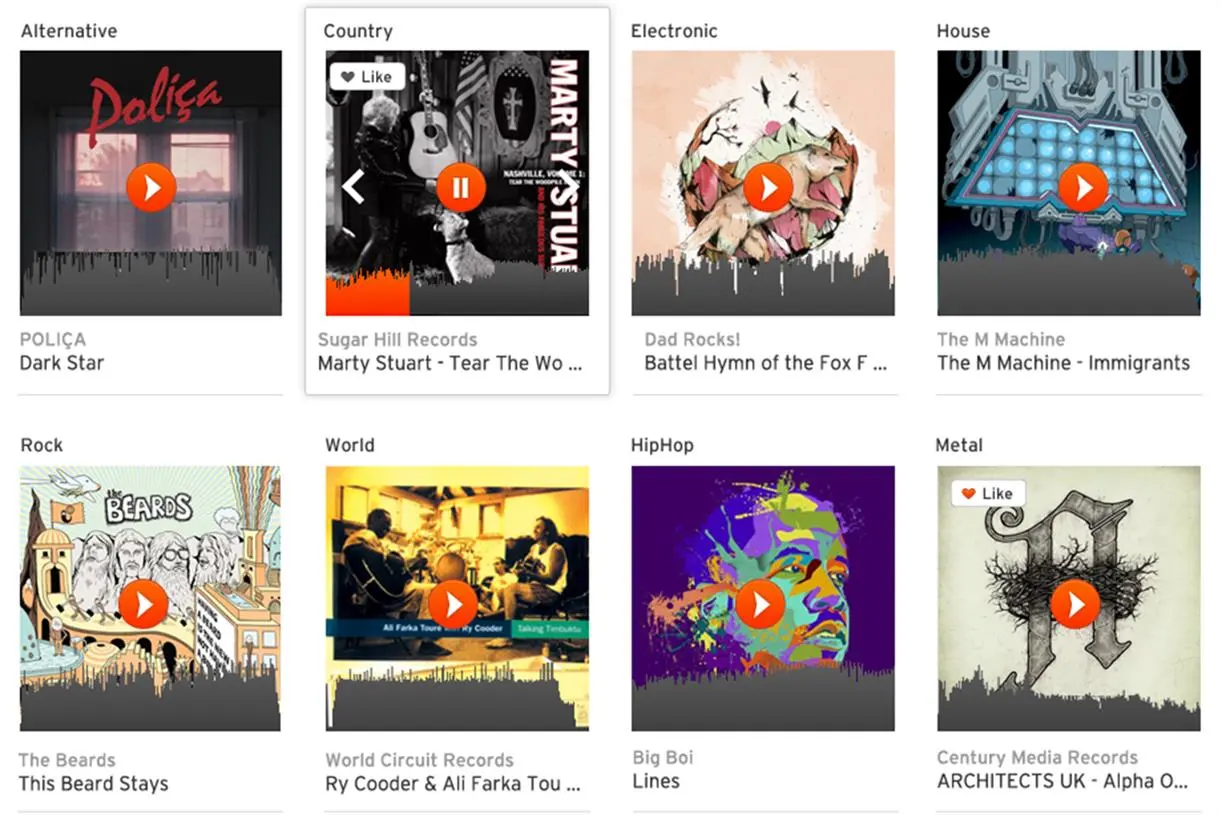
In an era where streaming music and audio content continues to soar in popularity, creators have a unique opportunity to capitalize on this demand by selling their own music and audio clips as digital products.
Musically inclined individuals can produce and sell original tracks, sound effects, and audio loops that can be utilized in various projects, including videos, podcasts, and advertisements.
This versatility allows for a wide range of applications, making your audio products appealing to content creators, filmmakers, and marketers alike.
By leveraging additional audio platforms like AudioJungle, SoundCloud, and Bandcamp, you can effectively showcase your work and reach a broader audience eager for high-quality audio content.
Additionally, you can create music production software or sample packs that cater to aspiring musicians and producers, providing them with tools to enhance their own projects.
Pros:
- The ongoing popularity of streaming and digital content creates a consistent market for music and audio products.
- Your audio clips can be used across various media, including videos, podcasts, and commercials, attracting a wide audience.
- You can diversify your income from your audio digital products by offering various audio products, such as original tracks, sound effects, or sample packs for music production.
Cons:
- The market for music and audio clips is highly competitive, making it challenging to stand out and attract buyers.
- Understanding copyright and licensing can be complex; missteps could lead to legal challenges regarding the use of your audio.
- Producing high-quality music and audio clips often requires a significant investment of time and effort, from recording to editing and marketing.
6. Stock Photos and Video

Selling stock photos or videos online has become a viable source of income for photographers and content creators looking to monetize their work.
The process typically begins with capturing high-quality images that cater to specific niches or themes, such as lifestyle, business, nature, travel, or food.
Once you have a collection of appealing photos, the next step is to choose stock photography platforms where you can upload and sell your images.
Popular platforms include Shutterstock, Envato, Adobe Stock, Getty Images, and Fourthwall, each offering a marketplace for photographers and videographers to showcase their work to a global audience.
Pros:
- Selling content through established stock platforms can expose your work to a vast audience, increasing your chances of making sales.
- There is a high demand for stock photos and videos across various industries, including advertising, marketing, publishing, and more, allowing you to cater to different niches.
- Selling stock photos or videos can help you build a diverse portfolio, showcasing your skills and attracting potential clients for other work.
Cons:
- The market is saturated, making it challenging to stand out among countless other photographers and videographers.
- Earnings can be unpredictable and may fluctuate based on market demand, seasonal trends, and competition.
- Once your work is uploaded and sold, you may have limited control over how they are used, which can be a concern for some photographers regarding copyright and misuse.
7. Software and Apps
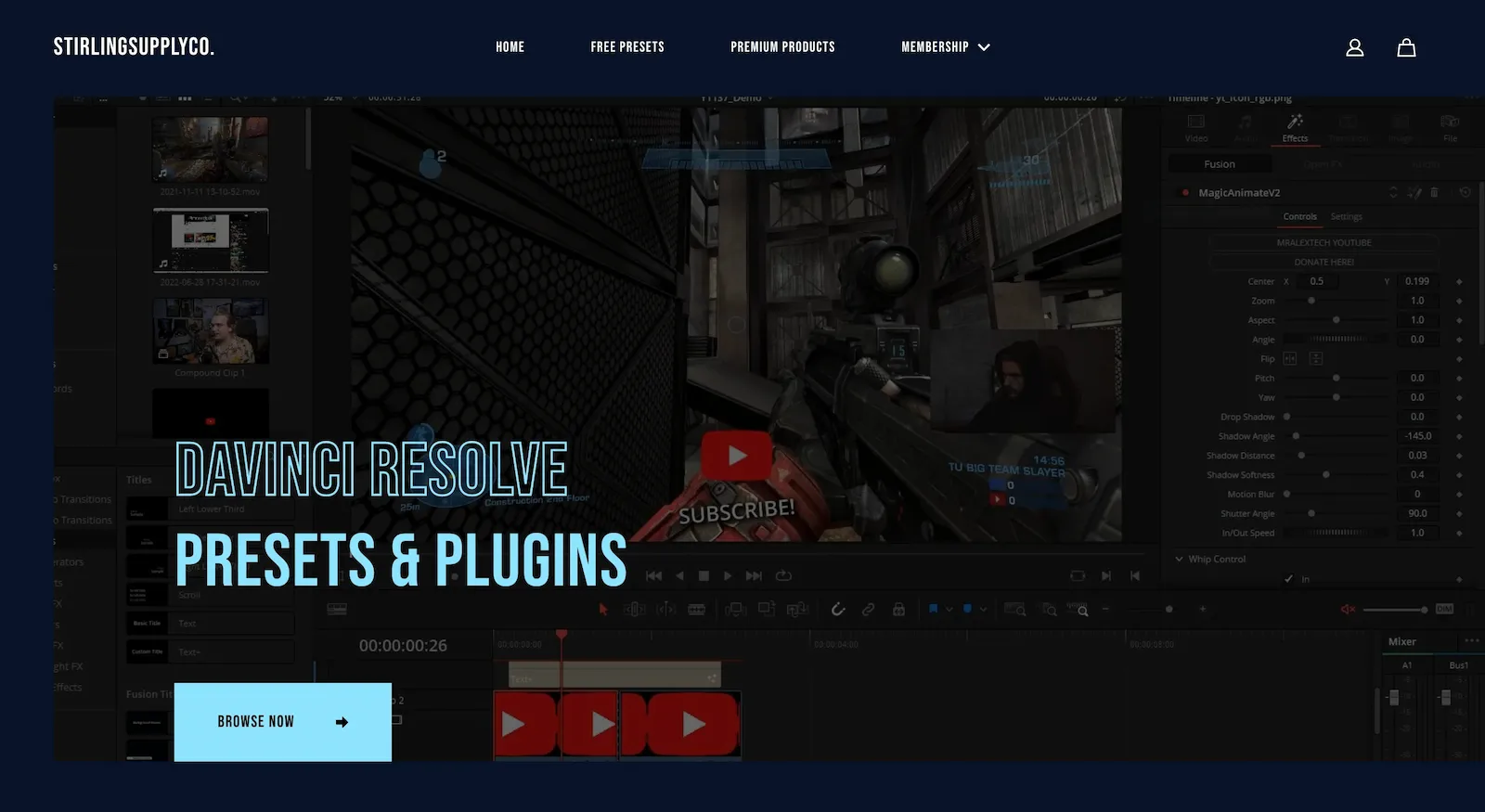
Selling software applications presents a lucrative opportunity for creators eager to enter the ever-expanding digital products market.
By developing digital products to sell like design software tools, mobile games, or specialized apps, creators can effectively address specific user needs, providing valuable solutions that enhance daily tasks and hobbies.
Additionally, offering supplementary resources such as editable templates, presets, and plugins can generate additional revenue by helping users understand advanced software programs.
For example, Patrick Stirling successfully leverages his platform, stirlingsupply.co, to sell DaVinci Resolve presets, tutorials, and templates. Stirling's growing audience highlights the demand for high-quality, niche software products that streamline the creative process for video editors.
Pros:
- Implementing a subscription-based model can generate ongoing income beyond the initial sale of your software.
- Countless opportunities to create software tailored to various niches, appealing to different user demographics.
- Software applications often address specific pain points, making them invaluable resources for users.
Cons:
- Creating high-quality software requires a significant investment of time and money in development, testing, and support.
- Developing software necessitates technical expertise, which can be a barrier for some creators.
- Software requires continuous updates, bug fixes, and customer support, which can be time-consuming and resource-intensive.
8. Graphic Designs
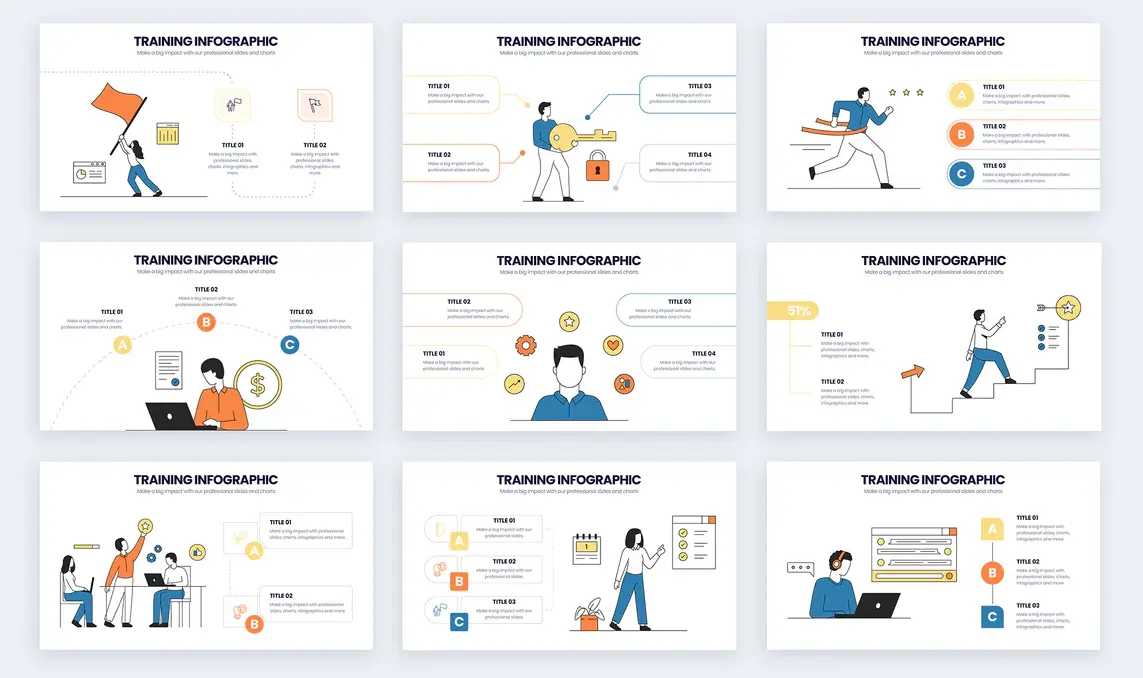
Graphic designs can be sold to a variety of clients, including small businesses, marketing agencies, content creators, and individuals seeking custom artwork for personal projects.
This versatility allows designers to connect with different sectors, providing tailored solutions that meet specific client needs.
Unlike digital art, where you have total freedom to express your creativity, graphic designs are often more structured and focused on achieving a particular outcome, making them inherently client-centered.
Designers must consider branding guidelines, target audience preferences, and the overall message their clients wish to convey through their visuals.
By offering products like logos, social media graphics, infographics, and printable art, designers can tap into diverse markets, catering to specific demands and challenges faced by their clients.
Pros:
- Graphic designs can be marketed to various clients, including businesses, influencers, and everyday consumers, increasing sales opportunities.
- Designers can explore different styles and themes, allowing for personal expression and innovation.
- Once designs are created, they can be easily scaled and adapted for different uses, such as print, web, and merchandise.
Cons:
- Clients who pay more for graphics expect high-quality, professional designs, so failing to meet these standards can lead to negative reviews and diminished sales.
- Producing high-quality graphic designs requires significant time and effort, especially when perfecting details and ensuring client satisfaction.
- Designers must be vigilant about the copyright and licensing of their digital products, as unauthorized use of their work can lead to legal disputes.
9. Fonts

While graphic designs encompass a wide range of visual elements—such as logos, illustrations, and layouts—fonts specifically focus on typography and the unique styles of lettering.
Once a font is created, it can be uploaded to your site or a marketplace, requiring minimal ongoing effort beyond initial production.
Popular platforms like Creative Market and Envato Elements provide ideal venues for selling fonts, although they will take a percentage of your sales.
Fonts cater to a broad audience, including designers and businesses willing to pay for downloadable fonts with the proper commercial licenses for use in their projects.
This makes fonts a highly marketable and desirable digital product, allowing designers to express their creativity while capitalizing on the growing demand for unique typography in branding and design.
Pros:
- Unique and custom fonts are continually sought after in various industries, making it a profitable niche for designers.
- Designers can experiment with different styles and themes, allowing for personal expression in typography.
- Fonts can be marketed to many users, including graphic designers, businesses, and content creators.
Cons:
- The font market is saturated, making it challenging for new designers to stand out and attract buyers.
- Creating fonts demands specific technical knowledge and software proficiency, which may deter some aspiring designers.
- Designers must navigate copyright laws and licensing agreements to protect their work and avoid legal complications.
10. Membership Programs
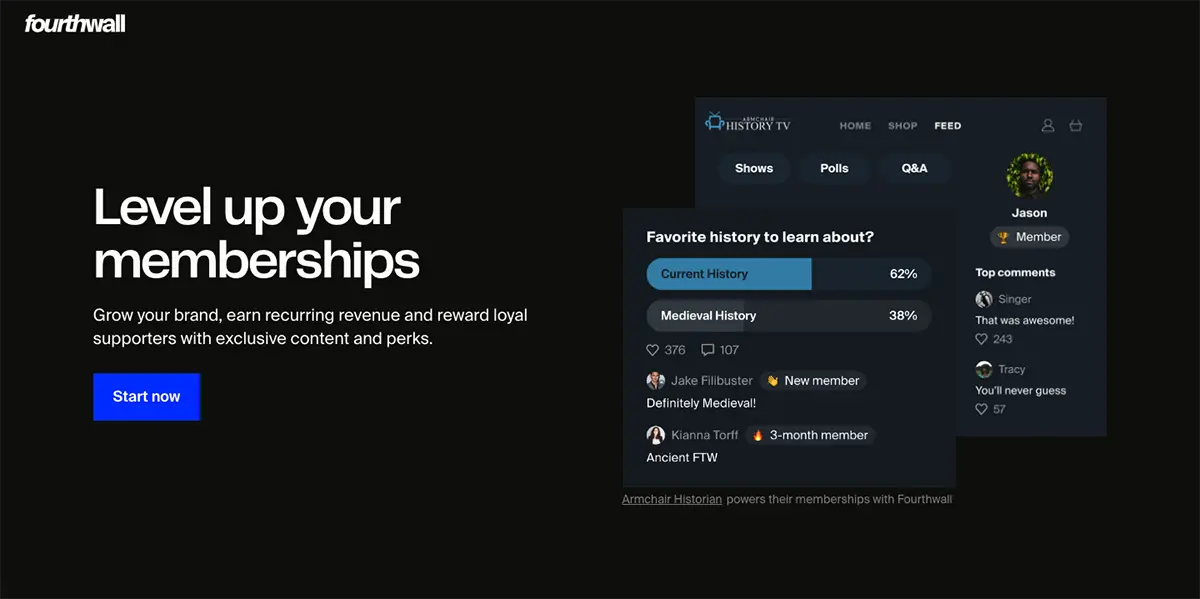
Subscription and membership programs can help creators connect with their fans on a deeper level while providing substantial revenue to help fund their creative endeavors.
This digital product idea is particularly beneficial for creators, podcasters, and streamers who are looking for additional avenues to monetize their content to their fans.
By offering exclusive content, such as behind-the-scenes access, member-only videos, early product releases, and interactive live sessions, creators can build a loyal community of supporters who feel valued and proud to support their content.
With Fourthwall Memberships, you can offer your supporters all kinds of exclusive bonuses through tiered memberships that let you provide various perks tailored to different levels of support. Your Fourthwall site perks may include personalized videos that create a better connection with fans, custom discounts on exclusive merchandise to incentivize purchases and early access to new content that keeps members engaged and excited about upcoming releases.
Pros:
- Subscriptions and memberships help promote a strong sense of community among fans, enhancing loyalty and support.
- This model provides multiple revenue streams for creators to monetize their content through member-only content, merchandise, and exclusive offerings.
- You have total control over your subscription and membership pricing.
Cons:
- Keeping members engaged over time is essential; if the value isn’t maintained, membership cancellations may occur.
- Relying on integrations and platforms means creators may face technical issues that could disrupt services.
- Setting up membership programs and promoting them effectively can take time and strategic planning.
11. Customizable Templates

Customizable templates, such as digital wedding invitations, productivity planners, and resume outlines, allow users to personalize their projects easily without starting from scratch.
This scalability makes templates an attractive option of digital products to sell, as they can be sold repeatedly with minimal additional effort.
Platforms like Canva or Microsoft Word can be utilized to design these templates, enabling creators to export them as PDF files for distribution.
This makes it easier to sell this digital product idea on platforms like Fourthwall, where creators can set up online stores, manage transactions, and reach a broader audience without the need for complex e-commerce solutions.
Pros:
- Creating customizable templates requires minimal financial investment, as you primarily need design software, which often has free or low-cost options.
- Templates can be easily scaled; a successful design can be marketed to a large audience without significant changes.
- There is a wide variety of customizable templates to create, catering to different niches and audiences, from wedding planning to professional resumes.
Cons:
- Templates typically sell for lower prices (often $5-$10), requiring a high volume of sales to achieve significant profits.
- The template market is highly competitive, making it challenging to stand out among numerous free and paid options.
- Some users may prefer more interactive or dynamic solutions than static templates, potentially limiting their appeal.
12. Web Assets

Web assets are digital products to sell that are designed to enhance online creations, providing valuable tools that individuals and businesses can use to improve their digital content.
These assets can include a wide variety of items, such as stock vector illustrations, icon sets, Procreate brushes, Instagram filters, Twitch screen overlays, WordPress themes, and AR filters.
Creating web assets typically requires an intermediate skill level and can take anywhere from a few hours to several days, depending on the complexity of the asset and the creator's familiarity with the design software.
Additionally, bundling assets with guides on customization can add value for customers, further enhancing your offerings.
Pros:
- Selling web assets allows creators to leverage their design skills and creativity.
- Once created, web assets can be sold multiple times with minimal ongoing effort, creating opportunities for passive income.
- There is a wide variety of web assets to create, appealing to different audiences and niches.
Cons:
- Access to professional software is necessary for creating web assets, which can involve significant upfront costs.
- Achieving profitability often requires a high volume of sales, necessitating a large audience and effective marketing.
- The market for web assets is highly competitive, making it challenging for new creators to stand out and attract buyers.
13. Fitness Programs

The fitness industry has seen exponential growth over the past decade, thanks in part to online programs and apps that make working out and healthy living more convenient.
Trainers and fitness creators can provide a range of offerings, including structured workout plans, meal guides, and instructional videos that cater to specific fitness levels or objectives, such as weight loss, muscle gain, or yoga practice.
By focusing on niche markets, such as postpartum fitness, senior workouts, or high-intensity interval training (HIIT), creators can effectively address the unique needs and preferences of their target audience.
As the demand for online fitness solutions continues to grow, selling digital fitness programs not only allows creators to monetize their knowledge but also empowers individuals to improve their overall well-being from the comfort of their homes.
Pros:
- The demand for online fitness solutions has surged, providing ample opportunities for creators to capture a dedicated audience.
- Creators can develop diverse programs targeting different fitness levels, goals, and preferences, appealing to a broad customer base.
- Creators can offer additional products, such as premium coaching sessions, nutritional plans, or merchandise, providing multiple income streams.
Cons:
- Fitness trends evolve rapidly, and creators must continually update their programs to stay relevant and meet customer expectations.
- There may be legal risks associated with offering fitness advice or programs, necessitating disclaimers and insurance to protect against potential injuries.
- Successfully selling fitness programs requires effective marketing strategies, which can be time-consuming and resource-intensive to implement.
14. Blogs and Articles

Writing blogs and articles can be a highly profitable endeavor for writers, as it allows them to share their expertise, connect with audiences, and monetize their content through various channels.
With high-quality and engaging articles, writers can attract traffic to their websites or platforms, leading to opportunities for advertising revenue, affiliate marketing, and sponsored content.
Platforms such as Medium, Upwork, and Freelancer allow writers to monetize their skills by earning money based on the number of views or clients they secure.
Many writers also leverage their blogs to sell digital products, such as eBooks or courses, further increasing their income potential.
Overall, the combination of traffic generation and diverse monetization strategies makes writing blogs and articles an attractive avenue for generating income.
Pros:
- Pay as an online writer can be highly lucrative, with skilled writers making substantial income.
- Writers have the flexibility to choose their topics and writing style, allowing for personal expression.
- Freelancing gives writers the ability to work with multiple clients, doubling their revenue efforts.
Cons:
- Earnings can fluctuate based on traffic, client demand, and market competition, making income less predictable.
- The online writing space is saturated, making it challenging to stand out and attract readers.
- If trying to make money off blogs and articles from your own site, keep in mind that your income heavily relies on traffic and attracting ad sponsorships.
15. Digital Finance Tools
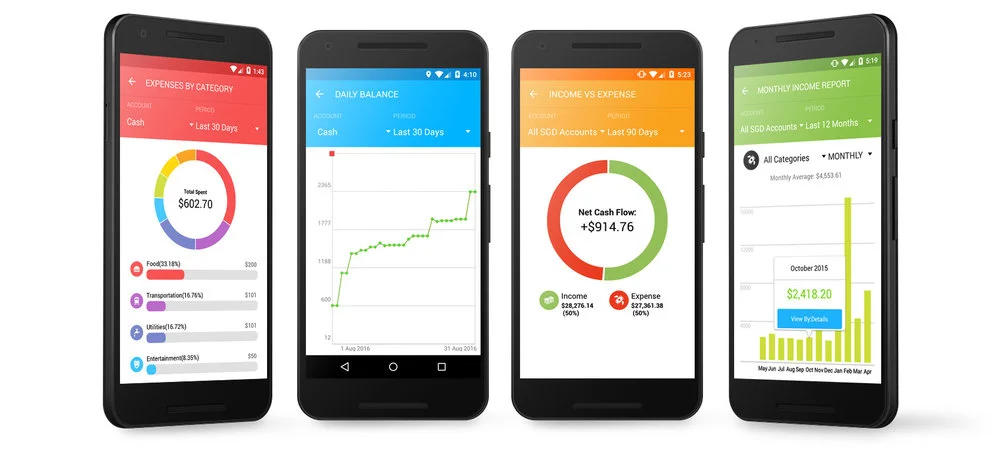
Digital finance tools are software applications or templates designed to help individuals and businesses manage their financial tasks more effectively.
These tools, such as mobile payment apps, digital wallets, budgeting software, and cryptocurrency platforms, are great digital products to sell because they cater to the increasing demand for financial literacy and personal finance management among consumers who seek easy-to-use resources.
As more people become aware of the importance of budgeting, saving, and investing, the market for digital finance tools continues to expand, providing creators with a unique opportunity to develop solutions that meet these needs.
Pros:
- There is a growing market for financial tools as individuals seek to improve their financial literacy and management skills.
- Offering subscription-based models for ongoing access to tools or updates can generate consistent revenue.
- Digital finance tools can be sold multiple times without the need for physical inventory or manufacturing.
Cons:
- These tools can be highly expensive to make and demand a lot of time, research, and testing.
- Customers expect high-quality, accurate, and user-friendly tools; failing to meet these standards can lead to negative feedback.
- Building awareness and driving traffic to your products necessitates ongoing marketing efforts to reach potential customers.
16. Digital Marketing Guides

In today’s digital landscape, where consumers increasingly rely on the internet for information, products, and services, having effective marketing strategies is crucial for success.
Through developing comprehensive guides or eBooks that cover various aspects of digital marketing - including social media management, search engine optimization (SEO), email marketing, content marketing, and paid advertising - creators can provide actionable insights that empower businesses to enhance their online presence and drive engagement.
These guides can include practical tips, step-by-step instructions, case studies, and real-world examples to help readers understand the best strategies for their specific needs.
By targeting various audiences, from small business owners to marketing professionals, creators can cater to different levels of expertise and industry requirements.
Pros:
- Digital marketing guides can cater to a wide range of users, including entrepreneurs, marketers, and students, expanding the potential customer base.
- Selling well-researched and comprehensive guides can help establish the creator as an authority in the digital marketing field, leading to increased credibility and recognition.
- As digital marketing evolves, guides can be updated and adapted to reflect current trends, ensuring they remain valuable to customers over time.
Cons:
- Digital marketing is constantly changing, so creators must stay informed about new tools, platforms, and strategies to keep their guides relevant.
- Developing comprehensive and well-researched guides can be time-intensive, requiring significant effort in both writing and design.
- Unlike live training sessions or workshops, written guides may lack the interactive elements that some learners prefer, potentially limiting engagement.
How to Create Your Digital Products
Creating digital products to sell online may seem daunting, but the process is simple and can be a highly fulfilling experience. Here are a few steps that you can follow to create digital products:
1. Choose a Niche
The first thing you should do is identify the niche market you want to target with your digital product, whether it's a course, eBook, or software. Your niche is most likely the content that your audience finds the most engaging. Don’t be afraid to lean into this niche when creating digital content to sell.
2. Research and Plan
Once you identify your niche, it's time to research your audience's needs as well as competitors' offerings. Find out what your target audience wants, and how you can differentiate yourself from other podcasters, Etsy sellers, Shopify or Fourthwall creators, etc. Then, create a plan detailing the product, its features, and its marketing strategy.
3. Create a Prototype
Before launching, it's essential to create a prototype to ensure your digital product is user-friendly and engaging. Send it to your friends or fellow creators to see what they think.
4. Validate the Product
Before investing all your resources, it's essential to validate your product in the market. This means getting feedback from your target audience, testing your product's performance, and fine-tuning it based on customer feedback. We recommend doing this by:
- Asking your fans in an interactive story on Instagram
- Posting a YouTube Poll
- Asking your followers on Twitter (X)
5. Create the Product
Now it's time to bring your product to life. Depending on the kind of digital product you're creating to sell online, you may need specialized tools. For example, you can use tools like Adobe Creative Suite, Canva, or Figma to create digital art and graphics or course creation software like Teachable or Thinkific to create an online course. Explore digital tools that can help you accelerate the product's creation process and ensure quality.
How to Sell Digital Products
Once you have your product ready, now is the time to sell! While creating quality digital products is vital, it shouldn't be the end goal. You want to sell them and reach your target audience. Here are four steps for selling digital products successfully:
1. Find the Right Platform
You can sell digital products on nearly any platform, including your website, social media, email, and third-party marketplaces.
However, the platform you choose should provide a straightforward checkout experience, easy shipping, and a comprehensive management system for sales and inventory.
A seamless user experience is crucial to converting visitors into customers, as potential buyers may abandon their carts if the purchasing process is too complicated or lengthy.
Leading platforms to consider include Etsy, Fourthwall, or Shopify, each of which offers unique features tailored for selling digital goods.
2. Set a fair price point
Pricing your digital products can be tricky. You want to make a profit, but you also don't want to price your products too high, limiting sales. Do some research on what competitors are charging for similar products and consider the value you are offering. Fourthwall also offers tools to help you set prices fairly by offering promo codes and discounts. Here are some examples of pricing to get you started:
- Digital song singles are usually priced between $0.99 and $1.99
- Digital albums are usually priced between $9.99 and $19.99
- Coaching sessions are usually priced between $50 and $1000
- Custom videos are usually priced between $5 and $500
3. Use marketing strategies to promote your products
Once you have created and priced your digital products, it's essential to implement effective marketing strategies to promote them and maximize your reach.
Utilize social media platforms to showcase your products through engaging posts, stories, and ads that capture your audience's attention.
Additionally, email marketing allows you to communicate directly with your followers, providing them with updates on new releases, exclusive offers, and valuable content that encourages conversions.
Collaborations with other creators or influencers in your niche can also amplify your message and expose your products to new audiences.
For more in-depth strategies on how to effectively market your digital products, check out this blog, which outlines actionable steps to enhance your online sales efforts and build a successful marketing plan.
Sell Your Digital Products on Fourthwall!
As we explored in this article, selling digital products on a site like Fourthwall can take your content creation to the next level! By utilizing the information we've provided, you can create high quality digital products, set fair prices, and develop strategies to promote your content and engage with your audience on whichever platform you choose.
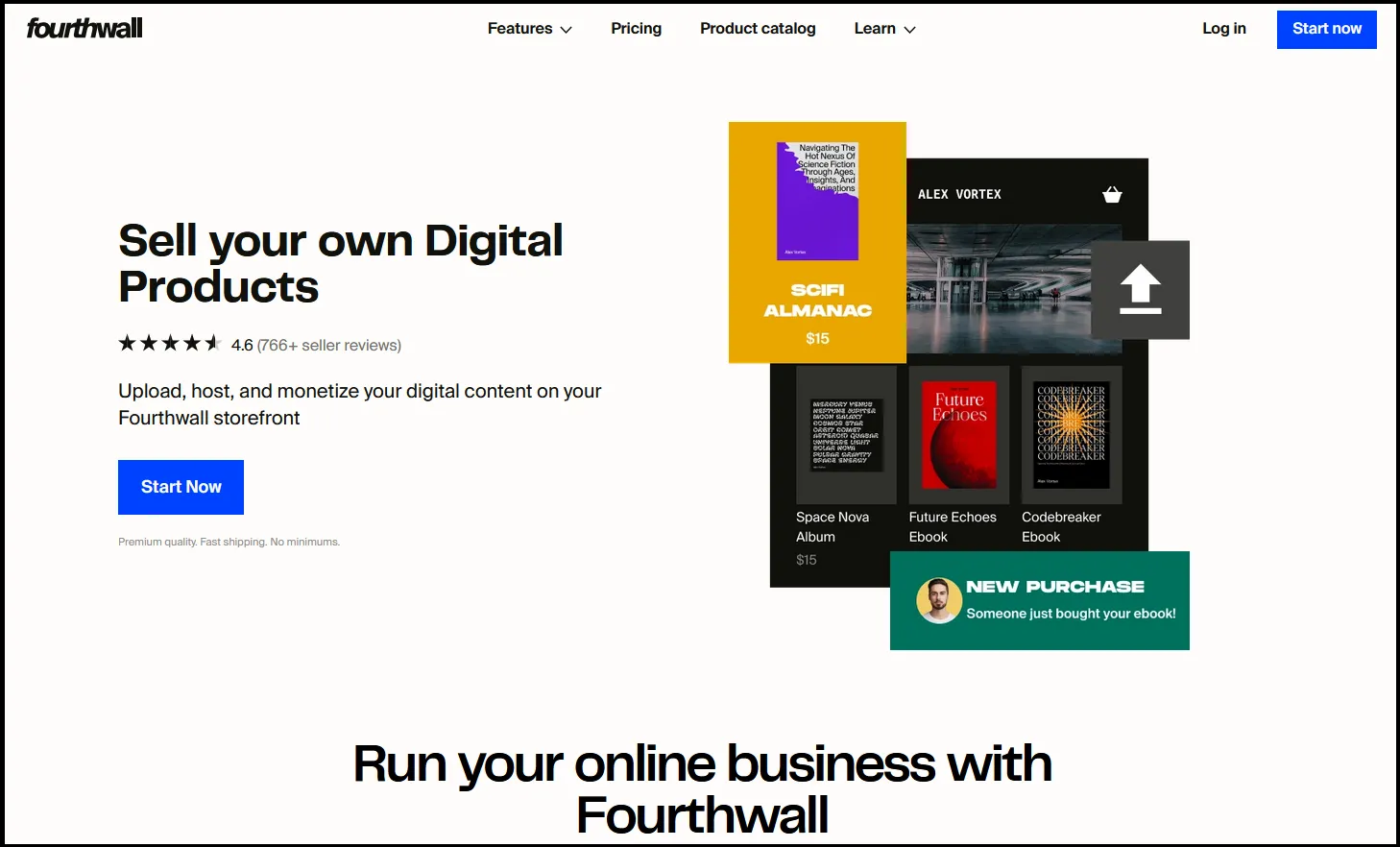
Ready to get started? Sign up for Fourthwall today to access a powerful creator ecommerce platform that enables you to launch your website, sell your digital or physical products, and offer memberships to your supporters! There are so many great things about selling your digital products on Fourthwall:
4 Benefits of Selling Digital Products Using Fourthwall
1. Easy and user-friendly platform
Fourthwall's platform is designed with creators in mind, making it easy and user-friendly to launch a website for your online marketplace and memberships.
2. All-in-one solution
Fourthwall offers an all in one solution for creators, eliminating the need to use multiple platforms to sell digital products, manage memberships, and interact with supporters.
3. Customization options
With Fourthwall, creators can customize their website, products, and membership tiers to align with their brand and meet the needs of their audience.
4. Secure payment processing
Fourthwall uses Stripe for secure payment processing, giving creators peace of mind when processing payments and managing transactions.

